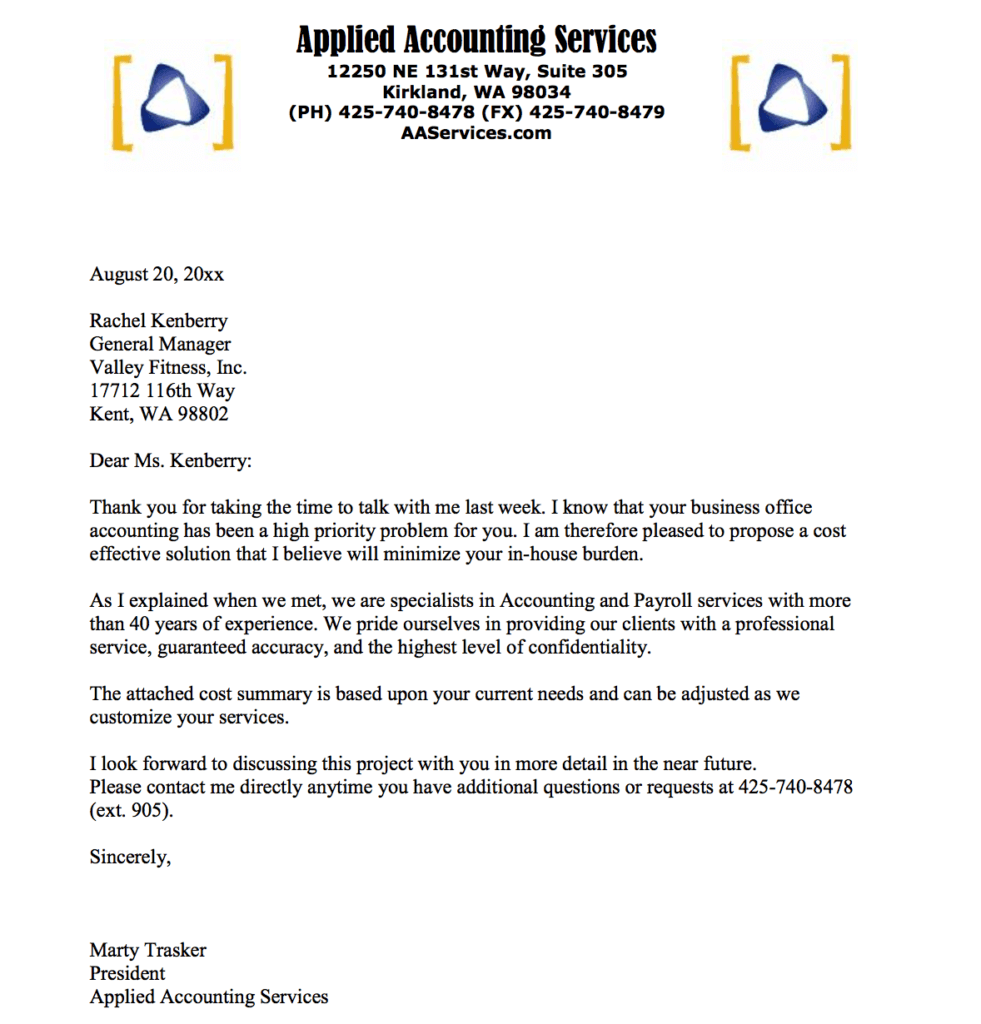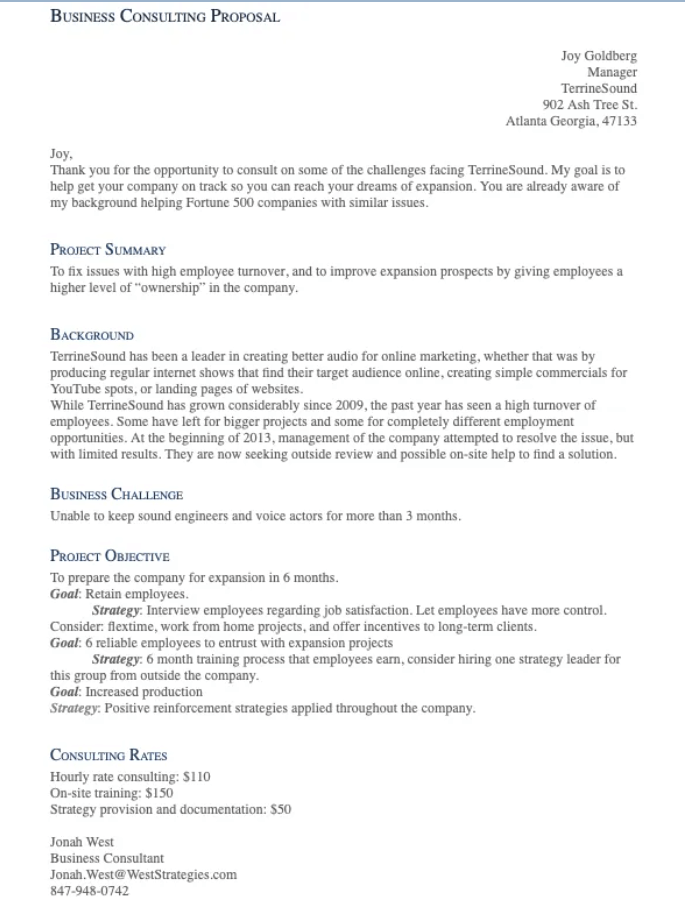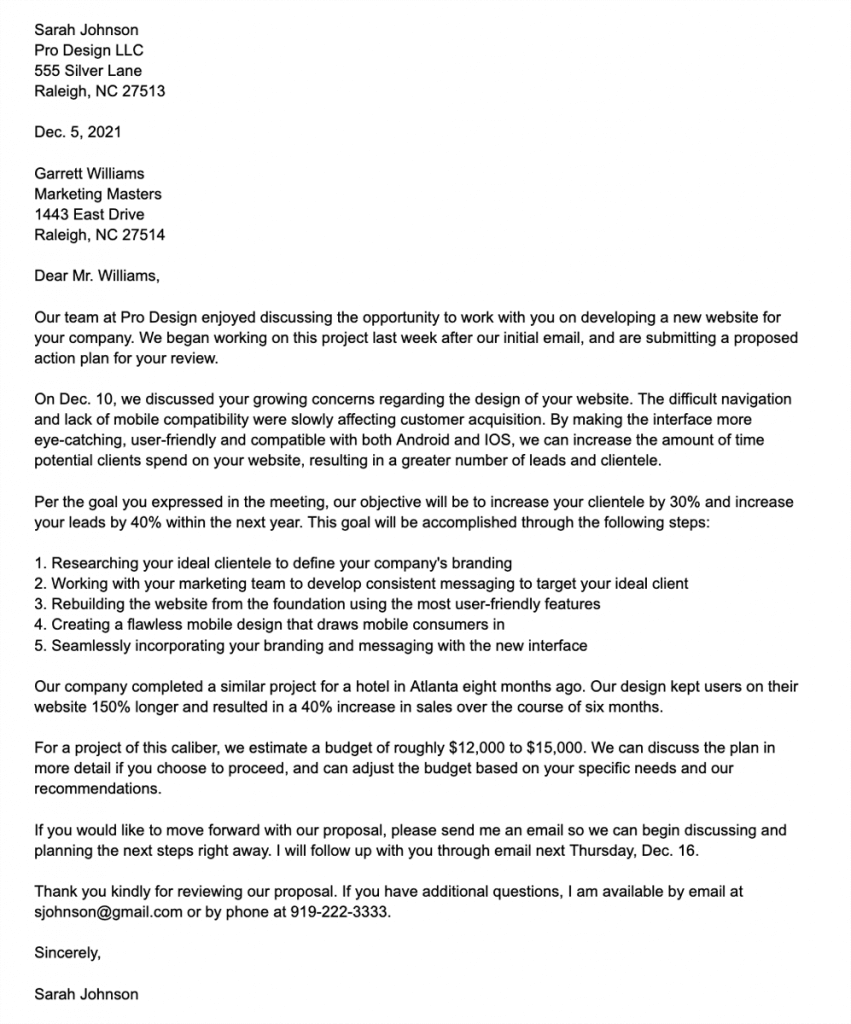-
News & Trends -
Sales -
Marketing Related Topics -
B2B Software Guides Related Topics -
Free Tools & Resources -
- About Us About Us
When it comes to connecting with potential clients, business proposal letters are a powerful tool for showcasing your products and services. Unlike traditional proposals that can be long and cumbersome, these letters capture your unique value in a concise, one-page format. This allows you to quickly convey how your offerings can benefit your prospective clients and guide them in exploring your business further.
To help you craft the best business proposal letter, I've compiled some helpful tips, a handy template, and business proposal sample letters designed for B2B professionals. Keep reading to learn more!
Although the terms “business proposal letter” and “business proposal” are often used interchangeably, a business proposal letter is a helpful tool for making a strong first impression. This one-page document serves as a concise summary or cover for a more detailed business proposal. Therefore, its primary purpose is to clearly and effectively highlight the key points of your proposal before it's read.
When sending your business proposal, include the proposal letter either as a hard copy at the beginning of your proposal or as the email body with the proposal attached. If your contact might share the email, make sure the letter is the first page of the proposal. The letter should summarize and complement the proposal, ensuring both documents align.
Businesses often use a one-page proposal that includes both a letter and details for smaller projects. For more guidance on writing a full proposal and its connection to your letter, refer to our article on how to write a business proposal.
A well-crafted proposal letter is typically formatted as a single page, containing three or four paragraphs and fewer than 400 words. To write an effective business proposal letter, make sure to include the following five elements:
Although it's not mandatory to include a proposal letter, doing so can enhance your professionalism and help establish trust and credibility with your audience.
It also provides necessary context and offers a straightforward pitch that engages readers. Whether sent via email or as a printed copy, ensure that your proposal letter is clear, polished, and memorable.
I’ve created a free business proposal letter template that incorporates the key elements listed above, along with examples of what to include for each section. You can download it below and then personalize it to your specific sales situation by simply replacing the words in parentheses (aka, the fields) with your own writing.
To create a business proposal letter, keep the letter concise, easy to scan, and tailored to your prospect's specific goals. A personalized, well-structured letter shows that you have listened attentively, which sets winning proposals apart from generic outreach.
Below, I build on the five key elements and guide you in completing them using writing prompts.
Business headings add a professional touch to your business proposal letter and include contact information for both your business and the recipient, such as the business name, address, and points of contact.

Make sure to include:
Business headers are most appropriate when the letter is the first page of a full proposal document. If you're writing it directly inside the email body, omit this section entirely to keep the message tight.
The introduction is the first part of your letter's body. It serves as an opportunity to reintroduce yourself and remind the recipient — whether a lead, prospect, or other parties — why you’re sending the associated proposal.
This section enables you to provide relevant social proof to engage readers before they review the full proposal, and to hint at the overall purpose.

Start with a greeting (e.g., “Dear {Prospect Name}”) and craft a brief, personalized paragraph that connects your previous conversations to the proposal. You can also use the information below to structure your introduction.
With AI tools accelerating communication, business prospects now expect higher-quality personalization. Use AI or CRM intelligence to gather insights, but always rewrite in your own voice to maintain authenticity. These elements combine to create a warm, relevant introduction.
This is the most substantial section (about 175 words). It previews the attached proposal and clarifies the value your solution provides. In this section, your goal is to reaffirm the prospect’s need and introduce exactly how your solution addresses it.
Specifically, the statement of purpose serves as a summary of your business proposal, including the problem, your solution, and the benefits the prospect will receive. This gives you a chance to highlight the most critical points of your proposal and accurately communicate your elevator pitch or unique selling proposition (USP) for the scanning reader.
Include the following:

It’s still best practice not to include costs in this section unless pricing is a competitive advantage. Buyers are more receptive to cost once they understand value, so focus on your key differentiators and value-add.
Typically, the next step will be to review your attached proposal. It may also involve scheduling a call or meeting to discuss the proposal further and address any questions that have arisen during the review. Therefore, the call to action (CTA) guides the prospect toward the next step.

For this section, use concrete language with a specific ask, such as the CTA examples listed below:
B2B buyers increasingly prefer frictionless scheduling. Including a scheduling link (such as Calendly or HubSpot Meetings) is now considered best practice rather than optional.
Close with one or two sentences expressing your appreciation and confidence in the partnership. Maintain a warm, professional, and consistent tone consistent with your brand's voice. Then add a sign-off (“Sincerely”) followed by your full name and contact details. Finally, a handwritten or digital signature adds a personal touch and remains a common practice.

If you’re sending via proposal software, you can use built-in e-signature options or insert a scanned signature image directly into the PDF.
When crafting a business proposal letter, it’s essential not only to focus on the necessary steps for its creation but also to be aware of common pitfalls. Here’s a list of mistakes that can undermine the effectiveness of your proposal.
By being mindful of these common mistakes, you can create a more compelling business proposal letter that resonates with your audience and increases your chances of success.
Reviewing different business proposal letter examples can help you see how various industries present their solutions, highlight value, and persuade prospects to move forward. Use the examples below to understand common formats and phrasing, then adapt what works best for your own proposal letter.
A service-based proposal letter gives a clear overview of your services while highlighting the prospect’s goals and how you plan to achieve them. This type of letter usually includes a broad scope of work, expected results, and, if needed, a brief pricing outline to help the prospect quickly assess your offering.

A marketing or consulting proposal letter emphasizes the business outcomes you can achieve for a potential client. It generally highlights strategic recommendations, expected ROI, and examples of past successes. This format works well when pitching partnerships that require greater trust and a long-term commitment.

A B2B SaaS proposal letter highlights how the software can address a specific business need or operational challenge. These letters often focus on efficiency gains, automation benefits, cost reductions, or performance insights, helping prospects quickly grasp the value your technology delivers.

Often, the best approach is to start with a proven template and customize it for your business. Then, incorporate techniques, phrasing, and structural ideas from examples like these to improve your version. Once you have a solid template, you can easily adapt it for each new prospect while keeping a professional, consistent format.
A business proposal letter should be one page or less in length. Keep it concise, focusing only on the prospect’s problem, your solution, key benefits, and the next steps.
An official business proposal is a detailed document outlining the terms of a deal, including a cover page, an executive summary, a proposed solution, qualifications, a timeline, pricing, and terms. It can also serve as a contract with a signature field. In contrast, a proposal letter introduces the main proposal by summarizing the solution, benefits, and terms on one page, making it ideal for smaller deals. Proposal letters usually accompany a comprehensive proposal rather than stand alone.
Send a business proposal letter after a prospect expresses interest, requests a proposal, or when you’re formally pitching a solution in response to an RFP or business opportunity.
Your business proposal letter sets the tone for the entire proposal and often determines whether a prospect feels confident enough to continue the conversation. By focusing on their goals, clearly communicating your value, and demonstrating a genuine understanding of their challenges, you lay the foundation for a productive partnership.
Keep your message concise, personalized, and outcome-driven to stand out from competitors and make a strong first impression. With the right structure and approach, your proposal letter can become more than just an introduction; it can serve as a strategic tool that advances the sale and increases your chances of winning the deal.
Want more proven sales strategies and ready-to-use templates? Join the Selling Signals newsletter for expert insights and step-by-step playbooks delivered straight to your inbox. Subscribe now!

Selling Signals delivers actionable advice for sales and marketing professionals. Learn strategies that help you hit targets, strengthen customer relationships, and win more business. Get expert advice on lead generation, sales processes, CRM software, sales management, and account management directly to your inbox.
Property of TechnologyAdvice. © 2025 TechnologyAdvice. All Rights Reserved
Advertiser Disclosure: Some of the products that appear on this site are from companies from which TechnologyAdvice receives compensation. This compensation may impact how and where products appear on this site including, for example, the order in which they appear. TechnologyAdvice does not include all companies or all types of products available in the marketplace.